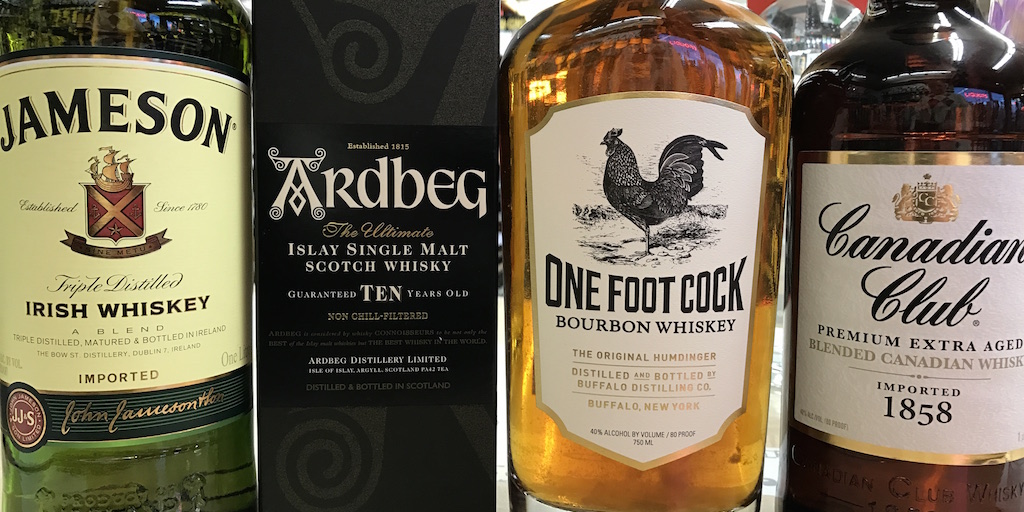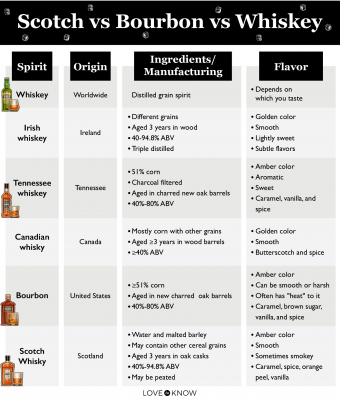Imagine savoring a glass of whiskey after a long day, the rich aroma filling your senses and the smooth taste warming your soul. But as you take another sip, you wonder: what exactly is the difference between Scotch and Bourbon?
If you’ve ever found yourself pondering this question, you’re not alone. Many whiskey enthusiasts and casual drinkers alike often find themselves curious about these two popular spirits. You’ll discover the unique characteristics that set Scotch and Bourbon apart. We’ll delve into their origins, ingredients, and production processes, providing you with a clearer understanding of what makes each whiskey special.
By the end, you’ll not only know the difference but also impress your friends with your newfound whiskey wisdom. So, grab your favorite glass and settle in—you’re about to embark on a flavorful exploration of Scotch and Bourbon!
Origins And History
Are you curious about the origins and history of Scotch and Bourbon? Understanding where these iconic spirits come from can deepen your appreciation for their unique qualities. Each has a fascinating story rooted in distinct geographical and cultural backgrounds.
Scotch Whisky Roots
Scotch whisky hails from the rugged landscapes of Scotland. Its creation dates back to the 15th century, when monks first started distilling spirits. Their goal was simple: find a way to use surplus barley.
The Scottish climate, with its crisp air and mineral-rich waters, plays a crucial role in shaping Scotch’s distinctive taste. Distilleries often take advantage of the local environment, using peat to dry malted barley, giving Scotch its signature smoky flavor.
Have you ever wondered why Scotch is spelled with a “whisky” while others use “whiskey”? It’s a nod to Scottish tradition. Drop the “e” and you can almost feel the Highland heritage.
Bourbon’s American Beginnings
Bourbon, on the other hand, is a true American creation, with roots in the late 18th century. It emerged in Kentucky, a place with abundant corn crops, which became the key ingredient.
Unlike Scotch, Bourbon relies on new charred oak barrels for aging. This imparts a sweet, caramel-like flavor, distinct from its Scottish counterpart. The American spirit of innovation led to this unique method.
Imagine the pioneers traveling westward, bringing their whiskey-making skills. They found fertile ground for their craft, laying the foundation for what Bourbon is today. Do you think the spirit of adventure flavors the Bourbon experience?
Understanding these origins not only enhances your knowledge but enriches your tasting experience. Next time you sip, consider the journey each spirit has taken. How does the history influence your choice between Scotch and Bourbon?
Production Processes
Scotch and bourbon, while both delectable whiskies, have distinct production processes that set them apart. Understanding these differences can enhance your appreciation of what makes each spirit unique. Let’s dive into the nuts and bolts of their production, exploring the key elements that define them.
Ingredients And Grain Choices
The foundation of any whisky is its ingredients. Scotch is primarily made from malted barley. This choice gives Scotch its rich, earthy flavor profile that many enthusiasts adore.
On the other hand, bourbon must be made from at least 51% corn. This corn base lends bourbon its sweeter, smoother taste. Have you ever wondered why bourbon feels a bit like a hug from the South? Now you know!
Distillation Methods
Distillation is where the magic happens. Scotch is traditionally distilled twice in pot stills, which helps maintain its complex character. These stills contribute to the depth and variety found in Scotch whiskies.
Bourbon, however, is often distilled using a continuous column still. This method is efficient and produces a cleaner spirit. Think of it as the streamlined process that delivers that quintessential American flavor.
Aging And Maturation Techniques
Aging is where time and patience transform raw spirit into a fine whisky. Scotch must be aged in oak barrels for at least three years. Many distilleries extend this period to develop more nuanced flavors.
Bourbon is aged in new charred oak barrels. This unique requirement imparts a distinctive vanilla and caramel profile. Ever tasted the warmth of bourbon that feels like a cozy fireside evening? That’s the charred oak speaking!
These intricate production differences make each whisky not just a drink, but an experience. Next time you savor a glass, think about the journey it took from grain to glass. Which process resonates more with your palate? The choice is yours.
Geographical Differences
Scotch and bourbon are both famous whiskeys. They have unique geographical roots. This influences their flavors and characteristics. Understanding these origins helps appreciate their distinct tastes. Let’s explore the geographical differences.
Scotch Regions In Scotland
Scotch whisky is crafted in Scotland. The country has five main whisky regions. Each region adds its own twist to Scotch. Speyside is known for its sweet and elegant whiskies. Islay offers bold, smoky flavors. The Highlands provide a diverse range of tastes. Lowland whiskies are lighter and more delicate. Campbeltown presents a briny, coastal influence. These regions give Scotch its varied flavor profiles.
Bourbon’s Kentucky Connection
Bourbon is deeply tied to Kentucky in the United States. Kentucky has the perfect climate for aging bourbon. Its limestone water adds a unique taste to the whiskey. The state produces 95% of the world’s bourbon. It’s often called the “Bourbon Capital of the World.” Kentucky’s rich history and tradition shape bourbon’s identity. The unique landscape and resources create a distinctive flavor.

Flavor Profiles
Exploring the world of whiskey introduces rich and varied flavor profiles. The differences between Scotch and Bourbon are fascinating. Each offers unique taste experiences worth exploring. Understanding these flavors enhances appreciation for each drink. Let’s delve into their distinctive characteristics.
Scotch Taste Characteristics
Scotch whisky often has a smoky flavor. This comes from drying malted barley over peat fires. The smoky aroma is one of its signature traits. Many Scotches also have fruity notes. These can include apple, pear, or citrus. Spices like cinnamon or nutmeg may also be present. A hint of vanilla or caramel offers subtle sweetness. Each region in Scotland contributes unique flavors. Islay Scotch is known for being intensely smoky. Speyside Scotch is often lighter and fruitier. The aging process adds depth and complexity. Older Scotches can have rich, mature flavors.
Bourbon Flavor Notes
Bourbon is known for its rich, sweet flavors. Corn is the primary grain in Bourbon, adding sweetness. Caramel and vanilla are common notes in Bourbon. These come from aging in new charred oak barrels. The oak imparts a distinctive flavor and aroma. Hints of spice like cinnamon or clove may be present. Some Bourbons have notes of toffee or honey. The aging process enhances these sweet characteristics. Younger Bourbons may taste more of corn. Older Bourbons develop richer, more complex profiles. Each sip offers a warm, smooth finish. Bourbon’s sweetness makes it approachable and enjoyable.
Legal Definitions
Understanding the legal definitions of Scotch and Bourbon is crucial for enthusiasts. Each spirit has unique standards that define its identity. These regulations ensure authenticity and quality. They also protect tradition and craftsmanship. Let’s delve into what makes each spirit legally distinct.
Scotch Regulatory Standards
Scotch is a whisky made in Scotland. It must follow strict guidelines. The Scotch Whisky Regulations 2009 set the rules. These laws dictate how Scotch is produced. It must age in oak barrels for at least three years. Only water and barley are allowed in its making. The distillation must occur in Scotland. The final product must have a minimum alcohol content of 40%. These standards preserve Scotch’s heritage.
Bourbon Legal Criteria
Bourbon has its own legal criteria. It is an American whiskey. The Federal Standards of Identity for Distilled Spirits govern its production. Bourbon must be made primarily from corn. At least 51% of the mash bill must be corn. It must be distilled to no more than 160 proof. Bourbon must age in new charred oak barrels. The aging process cannot add anything except water. The spirit must enter the barrel at no more than 125 proof. These criteria ensure Bourbon’s unique flavor.

Cultural Significance
Scotch and bourbon, both cherished whiskeys, differ in origin and ingredients. Scotch comes from Scotland, often smoky from peat. Bourbon, from the United States, uses at least 51% corn, giving it a sweeter taste. These differences highlight unique cultural traditions and regional preferences in whiskey production.
Whiskey aficionados often find themselves drawn into the rich tapestry of cultural significance surrounding Scotch and Bourbon. These spirits are not just drinks; they are symbols of tradition and identity. Whether you’re sipping a robust Scotch or a smooth Bourbon, each glass tells a story of its heritage.Scotch In Scottish Tradition
Scotch is more than just whiskey; it’s an emblem of Scottish pride and history. In Scotland, Scotch has long been intertwined with rituals and social gatherings. It’s a staple at celebrations like weddings and Hogmanay, the Scottish New Year. Scots often regard Scotch as a reflection of their land. Its flavors echo the rugged Scottish landscapes, with hints of heather and peat. This connection to the land adds a layer of authenticity and pride. You might find it interesting that Scotch is often shared to seal important deals or friendships. A personal experience comes to mind when I was in Edinburgh. I was invited to a local’s home, and we toasted with a dram of Scotch to honor our new friendship. It felt like participating in a time-honored tradition.Bourbon’s Role In American Culture
Bourbon, on the other hand, is deeply rooted in American history. It’s often associated with Southern hospitality and has become a symbol of American craftsmanship. You’ll find Bourbon at the heart of many American celebrations, from the Kentucky Derby to Thanksgiving. Bourbon’s history is closely tied to American independence and the frontier spirit. This spirit was evident when I visited a distillery in Kentucky. The tour guide spoke with pride about how Bourbon has been a part of their family for generations. Bourbon also plays a role in contemporary American life. It’s found in cocktails at trendy bars and is a favorite choice for those who appreciate a sweet, robust flavor. Have you ever tried crafting a classic Old Fashioned at home? It’s an experience that connects you to a piece of American heritage, right from your kitchen. Both Scotch and Bourbon carry more than just flavors in their bottles. They embody the stories and pride of their origins. So, next time you pour a glass, take a moment to appreciate the culture and history that comes with it.Popular Brands
Scotch and Bourbon are two beloved whiskey varieties. Each boasts unique flavors and aromas. Popular brands are integral to understanding their distinct characteristics. Famous Scotch labels and renowned Bourbon brands highlight their heritage and craftsmanship. Dive into the world of well-known Scotch and Bourbon names.
Famous Scotch Labels
Scotland offers a rich array of Scotch whiskey. Glenfiddich is a leader in the single malt category. Its smooth taste and classic profile attract many enthusiasts. The Macallan is famed for its rich, complex flavors. Aged in oak barrels, it delivers a luxurious experience. Laphroaig stands out with its peaty and smoky notes. This distinct character appeals to bold flavor seekers.
Johnnie Walker blends tradition with innovation. Known for its iconic blends, it offers varied flavor profiles. Each label has unique characteristics. From smoothness to intense smokiness, Scotch labels cater to diverse tastes.
Renowned Bourbon Brands
Bourbon brands showcase American craftsmanship. Maker’s Mark is celebrated for its smooth, sweet finish. Its distinctive wax seal is a hallmark of quality. Buffalo Trace offers deep, rich flavors. It has a long-standing reputation for excellence. Jim Beam is a household name in Bourbon.
Its approachable taste makes it a favorite. Wild Turkey delivers bold and spicy flavors. Known for its high rye content, it offers a robust profile. Each Bourbon brand provides a unique tasting experience. From smooth sweetness to intense spice, they offer variety.

Frequently Asked Questions
What Defines Scotch And Bourbon?
Scotch is whisky made in Scotland, primarily from malted barley. Bourbon is American whiskey, made mostly from corn. Scotch usually has a smoky flavor due to peat, while Bourbon is sweeter and richer. Both have distinct aging processes: Scotch in oak barrels, Bourbon in charred new oak barrels.
Is Scotch Smoother Than Bourbon?
Scotch and Bourbon have different flavor profiles. Scotch can be smooth, often with smoky notes. Bourbon tends to be sweeter and richer, providing a different kind of smoothness. Personal preference plays a big role in determining which is smoother for an individual palate.
How Does Aging Affect Scotch And Bourbon?
Aging enhances the flavors of both Scotch and Bourbon. Scotch often develops complex, smoky, and peaty notes. Bourbon gains sweetness, vanilla, and caramel flavors. The minimum aging for Scotch is three years, while Bourbon doesn’t have a specific requirement but benefits greatly from aging.
Do Scotch And Bourbon Have Different Ingredients?
Yes, Scotch is made from malted barley, while Bourbon is primarily made from corn. These base ingredients significantly contribute to their distinct flavors. Scotch’s barley gives it a smoky, rich taste, while Bourbon’s corn imparts a sweet, full-bodied flavor.
Conclusion
Scotch and Bourbon each offer unique flavors and experiences. Scotch comes from Scotland, often with smoky notes. Bourbon, from the USA, is sweeter and richer. Both have distinct aging processes and ingredients. Choosing between them depends on personal taste. Some prefer the complexity of Scotch.
Others enjoy the warmth of Bourbon. Each has its own history and tradition. Trying both can be a rewarding journey. Discover your preference by tasting different varieties. Enjoy the rich world of whisky, one sip at a time. Explore, taste, and savor every moment.

I’m someone who’s always been fascinated by how small differences can lead to big understanding. That’s why I love writing “What’s the difference between…” content; it helps me explore topics from multiple angles and explain them in a clear, practical way. Whether it’s tech, productivity, business, or everyday decisions, I enjoy making complex ideas easier to compare, understand, and act on.










